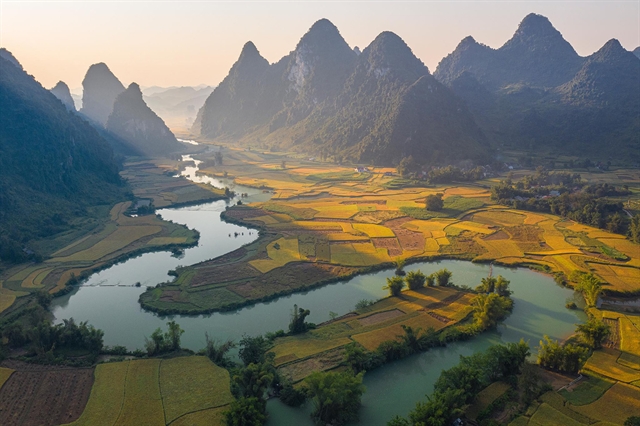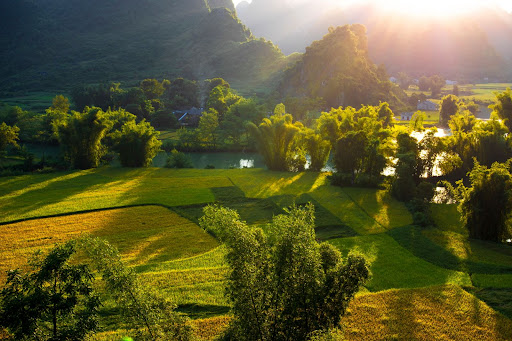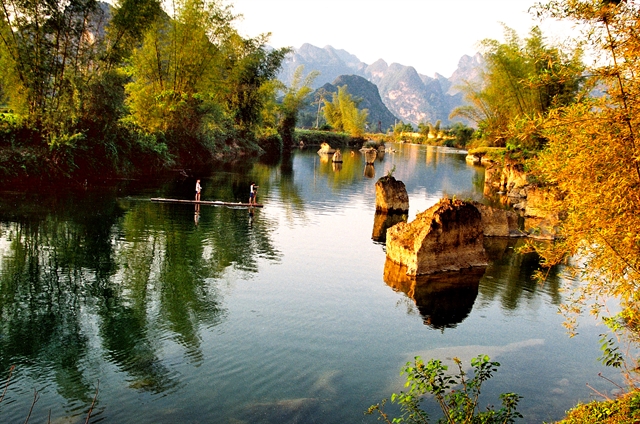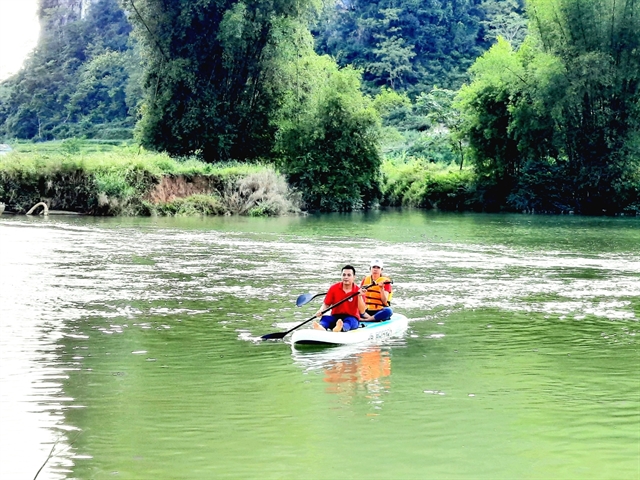[ad_1]

Thanh Giang
As one of the rivers flowing along the borders of the country, Quây Sơn River as poetic and beautiful as a picture. It runs through the rolling limestone mountains of Trùng Khánh District, Cao Bằng Province.
In the Sino-Vietnamese sense, Quây Sơn is a river flowing around the mountain. The river originates from countless small murmuring streams flowing down from the mountains along the length of the Việt Nam – China border, the confluence of two small tributaries from Phong Nặm and Ngọc Côn communes, forming the magnificent mainstream of Quây Sơn in Đình Phong Commune in Trùng Khánh. The river flows through Chí Viễn Commune to Co Muông Hamlet in Đàm Thủy Commune, before reaching the legendary Bản Giốc Waterfall.
The entire river is about 89km long, covering an area of 1,160sq.km. The average altitude of the river is 556m. The section flowing through Cao Bằng is 49km long, with a basin area of 475sq.km.
With its persistent internal force, Quây Sơn River is always full of water, weaving through the limestone mountains. River water from majestic and poetic Bản Giốc Waterfall flows, accreting fertile alluvium on both sides, creating a productive strip of land with lush crops all year round.
We went to Quây Sơn River in the early autumn days. Fortunately, the weather was very beautiful. The section of Quây Sơn River flowing through Co Muông Hamlet, Đàm Thủy Commune is very peaceful, flat and beautiful like a watercolour painting.
The weather was cool, the sunlight bright like honey, the sky blue, and the water of Quây Sơn River as clear as a giant mirror, with silhouettes of stilt houses and lush trees. In the distance, each flap of reed cotton bloomed dreamily on the hillsides, bamboos swing in the rustling wind, ripe rice fields look like a beautiful picture.

A bamboo bridge spans the narrowest part of the river, making the scene even more like a painting. Co Muông Hamlet was deserted, with a little sadness and loneliness leaning over the river.
From Bản Giốc Waterfall, we decided to wander up to Ngọc Côn Commune to see where the river flows into Việt Nam.
An idyllic, beautiful mountainous region appears on the riverside road from Ngọc Côn Commune to Phong Nậm Commune. Sometimes going through a spillway, a few young people could not contain their excitement and hurriedly stopped the car, waded into the river, splashed water and played.
We went up a mountain in Phong Nậm Commune to enjoy the full view of the river and mountains. From above, Quây Sơn gently bends around the rice fields and peaceful houses. In the distance, a stretch of limestone mountains runs to the horizon.
Except for days with prolonged heavy rain, the water of Quây Sơn River is emerald green all year round. Sometimes we saw a few rafts of fishermen who looked lonely against the immense blue.
While we were busy following the river’s flow from one village to another, we suddenly realised a “very Vietnamese” feature on the banks. Bamboo groves have grown on both banks of the river. Bamboos help keep the land, create shade for people to rest, and brings cool wind to the lullabies of mothers in the mountainous areas.
Following the river, soon we reached Hạ Lang District where Quây Sơn River forms a natural border between Việt Nam and China. Sometimes the river bends to China and then back to Việt Nam. The 49km long river section in Việt Nam is considered the most beautiful.

Getting out on the water
To be immersed in nature and feel the wonderfulness when discovering the Quây Sơn River, some young people go kayaking and Stand Up Paddle Boarding (SUP). In the area of Quây Sơn River, there are also some places to rent kayaks and SUP. This is a great way to experience nature.
To go kayaking on the river, visitors must go in groups with a group leader, with protective equipment.
According to Nguyễn Hải, who used to lead many groups of tourists rowing on Quây Sơn River, people can only row about 6-10km of the river, from Bản Giốc Waterfall to the Đàm Thủy border post, or along other routes such as Kéo Nà Village – Dít Village, Háng Thoang – Dít Village, Thoong Cót – Dít Village.
At a spillway, after warming up on the shore, the kayaks and their owners launched.

“Warming up to let your limbs get used to the water for a few minutes before paddling will help you feel less suffocated when you sit on the boat,” said Hanoian Phương Thủy, who has been passionate about kayaking for several years.
Sitting on the boat, Quây Sơn River begins to appear with an overwhelming beauty that we can’t feel when walking on the shore. At that time, the bamboo groves, fields, and mountains appear very close. Floating on the deep blue water, in the middle of the vast space, we feel like we are in heaven. — VNS
[ad_2]
Source link
